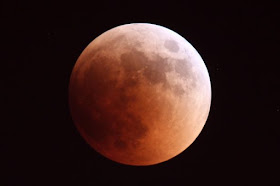February's full moon is traditionally called the Snow Moon
Astronomy enthusiasts are in for a treat this month, as three celestial events are set to coincide, putting on a spectacular display in the night sky.A full "Snow Moon", a lunar eclipse and a passing comet should all be visible from Earth on the same day. Anyone hoping to catch a glimpse of this rare event need only turn their eyes skywards on the night of February 10, through the to the morning of February 11.
February's Snow Moon will be no ordinary full moon for skywatchers in most parts of the world, as it coincides with a special lunar eclipse that will cast a shadow over the full moon's usual bright, glowing face. On Friday (Feb. 10), just 10 minutes after the full moon peaks, so will a penumbral lunar eclipse. The moon will spend more than 4 hours coasting through Earth's outer shadow, called the penumbra, and it will appear darker than normal.
While penumbral eclipses can be difficult to see and don't look nearly as dramatic as a total lunar eclipse — in which the moon passes through the darkest, central part of Earth's shadow — Friday's penumbral eclipse will be darker and more noticeable than most lunar eclipses of its kind. That's because the moon will veer so deeply into Earth's penumbral shadow that it will be almost entirely submerged in shade.
A penumbral lunar eclipse occurs when the Sun, Earth, and Moon align in an almost straight line.When this happens, the Earth blocks some of the Sun's light from directly reaching the Moon's surface, and covers a part of the Moon with the outer part of its shadow - also known as the penumbra.
The moon will first enter Earth's shadow at 5:32 p.m. EST (2232 GMT), and its moonlight will slowly but surely grow dimmer for a little over 2 hours.
After the eclipse peaks at 7:43 p.m. EST (0034 GMT on Feb. 11), the bright glow of the full moon will take about another 2 hours to return to normal.
The moon will be completely outside of the penumbral shadow by 9:55 p.m. EST (0255 GMT on Feb. 11).
The Moon will rise at 16:44 GMT on the evening of February 10 and set at 07:30 the following morning. It will rise again at 17:56 GMT on February 11.
The penumbral eclipse is due to start at 22:34 GMT on February 10, peak at 00.43 on February 11, and end at 02:53.
Regardless of where you are watching it, the first and last 40 or so minutes of the eclipse will probably not be noticeable, Sky & Telescope senior editor Alan MacRobert said in a statement. "The outer part of Earth's penumbra is so pale that you won’t notice anything until the moon's edge has slid at least halfway in," MacRobert said, "so start looking about 90 minutes before mid-eclipse."
Friday's penumbral lunar eclipse will be visible from most countries of the world, with the exception of Australia, New Zealand and the East Asian countries along the Pacific coast. In the U.S., the state of Hawaii will miss out on the event.
Skywatchers across Europe, Asia, Africa and North America will all be able to see the lunar eclipse, though some regions will have a better view than others. The best places to see the eclipse from beginning to end are Europe, Africa and the eastern side of South America (including most of Brazil).
New Year Comet
Comet 45P/Honda-Mrkos-Pajdušáková is named after the astronomers who discovered it in 1948 - Minoru Honda, Antonín Mrkos, and Ľudmila Pajdušáková.It is a periodic comet, meaning it follows a predictable path around the sun, and can be seen from Earth every five and a quarter years.It has recently been dubbed the "New Year comet" as it started its journey across northern hemisphere skies at the tail end of 2016.
The comet will be visible to the naked eye as it makes its closest approach to Earth on February 11.
Link HERE
Love and light,
Trace
xoxo






No comments:
Post a Comment
blessings........